
Eudonia philerga is a species of moth of the family Crambidae. This species was first described by Edward Meyrick. It is endemic to New Zealand, found throughout the country, and regarded as common. Larvae feed on moss. Adult moths have been observed on the wing more frequently from October to April, and are attracted to light.

Protyparcha is a genus of moths of the family Crambidae. It contains only one species, Protyparcha scaphodes, which is endemic to New Zealand, where it is known only from Auckland Islands. Both the genus and species were described by Edward Meyrick in 1909.
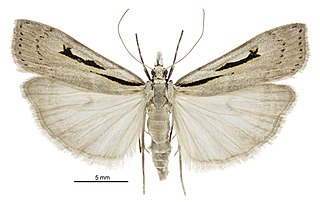
Scoparia rotuella is a species of moth in the family Crambidae. It was first described by Cajetan Felder, Rudolf Felder and Alois Friedrich Rogenhofer in 1875. It is endemic to New Zealand and, although considered localised, is found throughout the country. As at 2022 the life history of this species is largely unknown, but it has been hypothesised that this species may have two broods a year. Adults are on the wing all year round and are attracted to light.

Scoparia parmifera is a moth in the family Crambidae. It was described by Edward Meyrick in 1909. It is endemic to New Zealand.

Scoparia acharis is a moth of the family Crambidae. It was named by Edward Meyrick in 1884. This species is endemic to New Zealand and has been observed in both the North and South Islands. The preferred habitat of this species is native forest and in the South Island S. acharis has been observed in beech forest. The larval host of this species is moss. Adults are most commonly on the wing from November to January, although this species has been observed from October until March.
Scoparia fragosa is a moth in the family Crambidae. It was described by Edward Meyrick in 1910. It is endemic to New Zealand, where it has been recorded from the Kermadec Islands.

Scoparia illota is a species of moth in the family Crambidae. It is endemic to New Zealand. The larvae of this species are leaf miners.
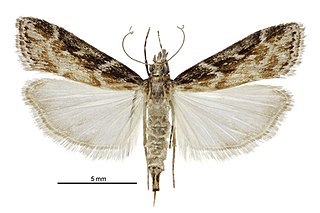
Scoparia molifera, also known as the leather-leaf Scoparia, is a species of moth of the family Crambidae. This species was first described by Edward Meyrick in 1926 and is endemic to New Zealand. It can be found in the North and South Islands. The larvae of this species make silk tunnels from which they mine the leaves of their host, the leather-leaf fern Pyrrosia eleagnifolia. Adult moths are on wing from December to February and are attracted to light.

Scoparia triscelis is a species of moth in the family Crambidae. It was described by Edward Meyrick in 1909. It is endemic to New Zealand.

Scoparia ustimacula, also known as the black-marked brown Scoparia moth, is a species of moth in the family Crambidae. It was described by Cajetan Felder, Rudolf Felder and Alois Friedrich Rogenhofer in 1875. It is endemic to New Zealand and can be found in the North, South and Stewart Islands. This species inhabits dense native forest at altitudes from sea level to approximately 1000 m. Although little is known of the life history of this species, larvae have been observed feeding on Hydrocotyle species. Adults are on the wing year round but are more commonly observed from September to March. Adults are nocturnal, are attracted to light and have been collected by beating scrub.
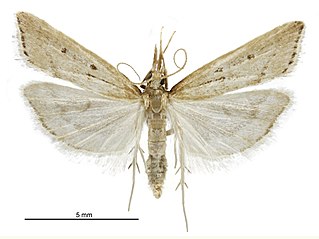
Antiscopa elaphra is a moth in the family Crambidae. It is endemic to New Zealand and has been observed in both the North and South Islands. Adults of this species are on the wing from August until March and are attracted to light. In 2020 this species had its DNA barcode sequenced.

Antiscopa epicomia is a moth in the family Crambidae. This species was first described by Edward Meyrick. It is endemic to New Zealand and can be found throughout the country including on Auckland Island, Campbell Island, and the Kermadec Islands. It inhabits native forest, preferring damp, shaded forest ravines. Adults are variable in size and colouration and are on the wing all year but most frequently from October until March.
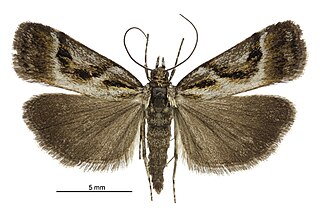
Eudonia hemicycla is a moth in the family Crambidae. It was described by Edward Meyrick in 1884. This species is endemic to New Zealand.

Eudonia leptalea is a moth in the family Crambidae. This species is endemic to New Zealand, including the Chatham Islands.

Eudonia zophochlaena is a moth in the family Crambidae. It was described by Edward Meyrick in 1923. It is endemic to New Zealand. It has been hypothesised that this species is a North Island endemic. The adults of this species are on the wing from December until February. The larvae of this species are leaf miners of the leather-leaf fern Pyrrosia eleagnifolia.
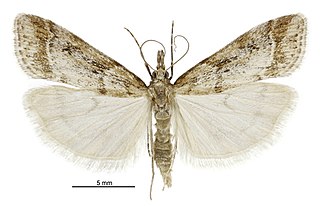
Eudonia chalara is a moth in the family Crambidae. It was described by Edward Meyrick in 1901. It is endemic to New Zealand.

Eudonia sabulosella is a species of moth in the family Crambidae. This species is endemic to New Zealand and is regarded as being common. The larvae of this species are known to damage pasture in New Zealand.
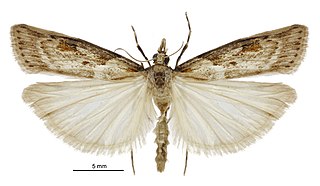
Scoparia dryphactis is a moth in the family Crambidae. It was described by Edward Meyrick in 1911. This species is endemic to New Zealand.
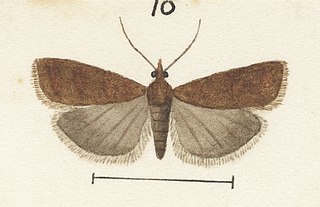
Scoparia parachalca is a moth in the family Crambidae. It was described by Edward Meyrick in 1901. It is endemic to New Zealand.

Proterodesma byrsopola is a species of moth in the family Tineidae. It was described by Edward Meyrick in 1909. This species is endemic to New Zealand.




















